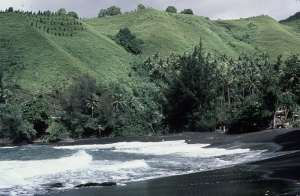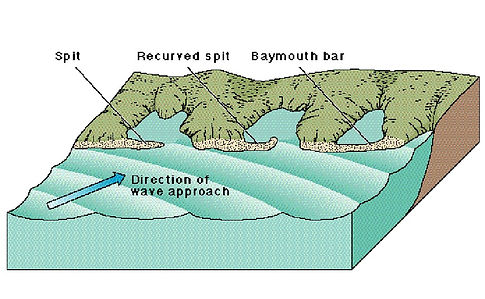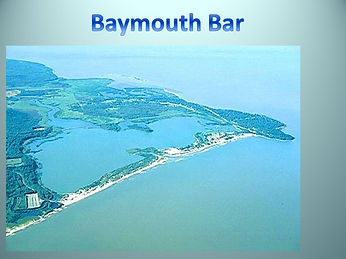Depositional Coastal Landforms
Beaches
A beach forms when waves deposit sand and gravel along the shoreline. and pebbles. Over time they are worn smooth from being rolled around by waves. The rocks usually reflect the local geology. Though sand is common to most beaches, a remarkable diversity of sediment size, from boulders to fine silt is found on beaches around the world. Larger particles and steeper slopes are found where wave action is high. Fine particles and gentle slopes are characteristic of beaches exposed to low wave action.
Figure 21.13 Black lava beach, Tahiti. Courtesy NOAA
Most midlatitude beaches undergo a cycle of erosion and deposition following the seasonal changes in wave action. During the winter, midlatitude storms are more vigorous producing more wave action and erosion. Hence, beaches tend to narrow during the winter. Wave action subsides during the summer as storms weaken somewhat favoring deposition over erosion and producing broader beaches.

Spits
Spits are also created by deposition. A spit is an extended stretch of beach material that projects out to sea and is joined to the mainland at one end. Spits are formed where the prevailing wind blows at an angle to the coastline, resulting in longshore drift.
Wherever there is a break in the coastline (e.g. across a river or a change in coastline direction) then material is deposited closest to the shore. This is because there are often counter currents and a loss in velocity, so material is dropped or deposited. Eventually this material builds up out into sea to form a spit. An example of a spit is Spurn Head, found along the Holderness coast in Humberside

Baymouth Bars
A baymouth bar is a spit that has grown to completely close off the bay from the sea. These bars usually consist of accumulated gravel and sand carried by the current of longshore drift and deposited at a less turbulent part of the current.


Lagoon
Some long beaches extend completely across the mouth of a river or a bay. These are called baymouth bars. They form sandy banks with the sea on one side and lagoons on the other side.
Lagoons are areas of shallow sea that have been separated from the main sea. They exist because of of the barrier that separates it from the ocean. The formation of lagoons depends on the barrier bars and sediment sources, waves, tides, and surf or storms and catastrophic events like storms, tsunamis, and hurricanes.
When sand is moved by the long coastal shore and gets deposited at the entrance of the bay, the accumulated deposits form a sandbar. As the deposition continues, that elongates the sandbar, eventually blocking the mouth of the bay creating a bay bar. This bay bar separates a part of the seawater from the open sea, and that enclosed sea water is what we popularly know as Lagoon

